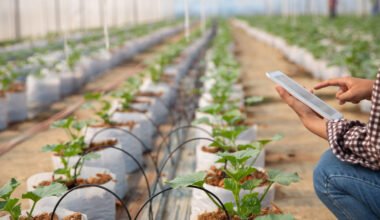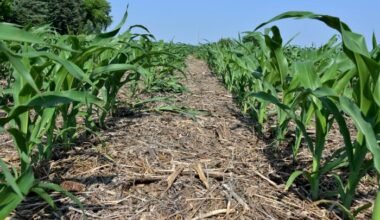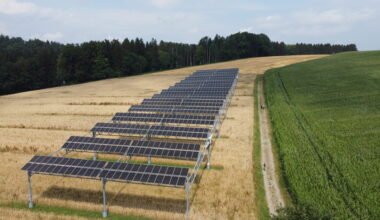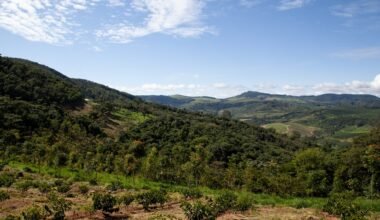Hey there, fellow green thumb! Have you been thinking about how to make your farm or agricultural business more environmentally friendly? Reducing your carbon footprint is not only good for the planet but also makes sense for your bottom line. The good news is, with some planning and effort, you can make your farm carbon neutral or even carbon negative.
In this article, we’ll walk you through the steps to calculate your farm’s carbon footprint based on things like energy usage, transportation, livestock, and crop management. Then we’ll give you tips for reducing emissions and offsetting any remaining carbon output. It may seem like a big task, but by making changes step by step, you’ll be well on your way to a greener, more sustainable operation. And you’ll be able to proudly say your farm is doing its part to fight climate change. Sound good? Then keep reading to learn how you can make your farm carbon neutral!

What Is Carbon Neutral Farming?
What exactly is carbon neutral farming? Basically, it means farming in a way that produces zero net carbon emissions. This means balancing the amount of carbon released with the amount absorbed or offset.
Reducing emissions
The first step is reducing emissions as much as possible. This includes things like:
- Using renewable energy like solar or wind to power equipment instead of fossil fuels
- Improving energy efficiency by upgrading to energy-efficient equipment and machinery
- Reducing deforestation since forests absorb carbon dioxide
- Optimizing fertilizer use so excess nutrients aren’t released as nitrous oxide, a potent greenhouse gas
- Managing livestock and manure to minimize methane emissions
Offsetting emissions
Even with reductions, most farms will still produce some emissions. The remaining emissions can be offset by:
- Planting more trees which absorb carbon as they grow
- Adopting sustainable agricultural practices like:
- Cover cropping: Planting crops that are tilled into the soil, increasing organic matter and carbon sequestration.
- Rotational grazing: Rotating where livestock graze to allow pastures to regrow, which promotes plant growth and carbon storage in the soil.
- Composting: Turning food scraps and manure into compost, which can be added to soil to improve soil health and increase carbon storage.
By balancing emissions reductions and offsets, farms can achieve carbon neutrality and do their part to mitigate climate change. It may require changes, but will result in a more sustainable farm for future generations. With hard work and innovation, carbon neutral farming is an achievable goal.
Benefits of Going Carbon Neutral for Farms
Going carbon neutral is one of the best things you can do for your farm’s future. Here are some of the major benefits of reducing your carbon footprint:
Cost Savings
- By using more energy efficient equipment and renewable energy sources, you’ll lower your utility bills and operating costs significantly over time. Things like solar panels, wind turbines, and biodigesters require an initial investment but can generate free energy for decades.
Increased Productivity
- When you make your operation more sustainable, you’ll likely need to examine your processes and make improvements. This often leads to gains in efficiency, reduced waste, and higher productivity overall – which boosts your bottom line.
Better Crop Yields
- Carbon neutral practices like cover cropping, crop rotation, and composting enrich your soil and improve soil health. This results in higher crop yields, more resilient plants, and better quality produce. Healthy soil is the foundation for agricultural success.
Tax Incentives and Grants
- Many governments and private organizations offer incentives, grants, and tax rebates for making environmental upgrades. Going carbon neutral may qualify you for these benefits, helping fund the transition.
Certification and Branding
- Becoming certified carbon neutral is a powerful way to strengthen your brand and stand out. Consumers increasingly want to support sustainable and eco-friendly businesses. Promoting your carbon neutral certification can attract new customers and open up sales opportunities.
Future Proofing
- As climate change brings more extreme and unpredictable weather, sustainable farms will have a competitive advantage. Diversifying crops, improving soil health, and increasing self-sufficiency helps shield you from risk. A lighter environmental footprint also ensures your farm can operate for generations to come.
Going carbon neutral may require an initial investment of time and money, but the long term rewards for your farm’s productivity, profitability, and longevity are well worth it. Making the transition now will put you in an excellent position to thrive well into the future.
Steps to Calculate Your Farm’s Carbon Footprint
To calculate your farm’s carbon footprint, you’ll need to measure the amount of greenhouse gasses emitted and compare it to your farm’s carbon sequestration. The main steps are:
Measure Sources of Emissions
The biggest contributors to a farm’s emissions are usually:
- Machinery and equipment: Calculate how much diesel, gas, and oil your tractors, trucks, generators, and other equipment use in a year. Their emissions can make up 50-90% of a farm’s total footprint.
- Livestock: If you have cattle, pigs, or poultry, measure how much methane and manure they produce. Livestock emissions vary depending on the animal and feed type.
- Fertilizers: Synthetic fertilizers release nitrous oxide, a potent greenhouse gas. Track how much nitrogen-based fertilizer you apply and its nitrogen content.
- Waste: Food waste, crop residues, and manure that decompose in landfills or waste lagoons also emit methane and carbon dioxide. Measure the amounts and how they are handled.
- Buildings and infrastructure: Heating, cooling, lighting, and powering farm buildings and equipment produces carbon dioxide emissions from the electricity and fuels used. Record your annual energy usage.
- Packaging and transportation: Calculate emissions from transporting goods to and from your farm, as well as any packaging used.
Once you have data on all sources, convert the amounts to metric tons of carbon dioxide equivalent (CO2e) to determine your total emissions. Compare this number to average emissions for farms of your type and size to see how you measure up.
Calculate Carbon Sequestration
Next, evaluate how much carbon your farm removes from the atmosphere through:
- Plants and trees: If you have woodlands, grasslands, or cover crops, they absorb CO2 as they grow. Estimates vary but 1 hectare of forest can sequester 2.5-5 metric tons of CO2 per year. Measure the areas you have and use standard rates to determine how much they may offset.
- Soil organic matter: As organic matter builds up in your soil, it stores more carbon. Most farms can sequester 0.5-3 metric tons of CO2 per hectare per year by using practices like reduced tillage, cover cropping, and composting. Test your soil organic matter and research rates for your region and farm type.
Compare your emissions and sequestration to determine if your farm is carbon neutral or the steps needed to achieve neutrality. Reducing emissions and increasing sequestration are the keys to success. With time and dedication, any farm can get there.
Steps to Reduce Your Farm’s Carbon Footprint
Reducing your farm’s carbon footprint is crucial for mitigating climate change. Every step counts, so consider making these changes to decrease emissions and do your part.
Convert to organic or eco-friendly practices
- Switching to organic or sustainable farming methods can significantly lower your carbon footprint. Organic farming avoids the use of synthetic fertilizers and pesticides, reducing emissions from production and transport. It also improves soil health, allowing the soil to store more carbon. Other eco-friendly practices like crop rotation, cover cropping, and composting enrich the soil and require fewer carbon-intensive inputs.
Use renewable energy
- Transitioning to renewable energy sources like solar or wind power is one of the biggest ways to slash emissions. Install solar panels, wind turbines, or geothermal heat pumps to generate clean energy for your farm. Not only will this shrink your farm’s carbon footprint, but it can also save you money in the long run. Many farms have found success using a hybrid of renewables and energy efficiency upgrades.
Improve energy efficiency
- Making your farm more energy efficient is an easy win. Use LED lights, install better insulation, upgrade old equipment to Energy Star certified models. Little changes like turning off lights and electronics when not in use can add up. An energy audit can help determine the best ways to cut usage on your farm.
Reduce waste
- Cut back on waste wherever you can. Compost food scraps and yard waste instead of sending them to a landfill. Reuse materials when possible. Recycle paper, plastic, glass, and metals. Donate or repurpose unneeded equipment and supplies. Small waste reduction steps make a big difference, especially when added up.
Consider carbon offsetting
- For emissions you can’t eliminate, consider purchasing carbon offsets. Offsetting involves investing in environmental projects like reforestation that remove carbon dioxide from the atmosphere. Offsetting allows you to balance out the impact of activities like equipment use, product transport, and more. Look for offsets from reputable organizations that verify the projects actually reduce emissions. We will get into this more in the next section.
By making these changes, you’ll be well on your way to making your farm carbon neutral and doing your part to fight climate change. Every small act matters in the effort to curb emissions and secure a sustainable future for agriculture. Together, we can all make a difference.
Going Completely Carbon Neutral: Offset Remaining Emissions
To achieve carbon neutral status for your farm, you’ll need to offset any remaining emissions that you can’t eliminate through reduction and efficiency measures. Offsetting involves investing in projects that reduce greenhouse gas emissions, like renewable energy, reforestation or methane capture. For every ton of carbon dioxide your farm emits, you offset an equal amount by funding projects that reduce emissions by the same amount.
There are several ways you can offset farm emissions:
Renewable Energy Credits
- Purchase renewable energy credits (RECs) to offset emissions from farm energy usage. RECs represent the environmental benefits of renewable energy and are sold separately from the actual electricity. Buying RECs helps fund the development of renewable energy sources like solar and wind. You can buy RECs through your utility company or from independent REC brokers.
Reforestation Projects
- Reforestation means planting trees in areas where forests have been cut down or depleted. As trees grow, they absorb carbon dioxide from the atmosphere. You can fund reforestation projects, often in developing countries, and claim the carbon offsets from the newly planted trees. Several organizations that offer reforestation offset projects verify the projects meet high standards.
Methane Capture
- If you own livestock, manure management and methane capture is an effective offset method. As manure decomposes, it releases methane, a potent greenhouse gas. You can install methane capture systems, like anaerobic digesters, that convert the methane into renewable energy. The avoided methane emissions are tradable carbon offsets. Some programs offer grants and incentives for anaerobic digesters and other manure management offsets.
Conservation Agriculture
- Using sustainable agricultural practices that improve soil health and reduce emissions is another way to generate offsets. Conservation agriculture includes no-till farming, cover cropping, improved grazing management and crop rotation. These practices sequester more carbon in the soil and reduce nitrous oxide emissions. You may be able to participate in carbon farming programs that award offsets for proven emissions reductions from conservation ag.
Offsetting remaining emissions is a key step to achieving complete carbon neutrality for your farm. Do your research to find reputable offset programs and methods that match your farm’s needs and values. With the right projects, you can offset 100% of your emissions and become carbon neutral.
Becoming Certified Carbon Neutral: Programs and Incentives
Becoming a certified carbon neutral farm shows your commitment to sustainability and can open up new marketing opportunities. There are a few well-known programs that can help you achieve this goal through a multi-step process.
Carbon Neutral Certification Program
- This nonprofit program helps farms calculate their carbon footprint and reduce emissions. You’ll measure direct and indirect greenhouse gas emissions from things like equipment, electricity usage, waste, and transportation. Then create a plan to cut emissions through renewable energy, efficiency upgrades, composting, and other steps. Once emissions are lowered, the remaining footprint can be offset by purchasing carbon credits that fund environmental projects. Upon verification of your plan and offset purchases, your farm will be certified carbon neutral.
Greenhouse Gas Protocol
- The GHG Protocol provides standards and tools for calculating and reporting GHG emissions. You’ll measure Scope 1 emissions directly from sources you own or control, like machinery or livestock, as well as Scope 2 indirect emissions from purchased electricity or heat. Scope 3 emissions from business travel, waste, and procurement are optional to report. The data can then be used to set reduction targets and determine a strategy to mitigate your impact. While the GHG Protocol itself does not certify or verify emissions, their methods align with most certification programs.
Incentives and Funding
- Some utility companies and local governments offer incentives, tax rebates, and grants for making sustainability improvements. Upgrading equipment, installing renewable energy systems, and implementing efficiency measures are often eligible for funding. Do some research to find programs available in your area. These incentives can help offset the costs of becoming certified carbon neutral.
Achieving carbon neutral certification for your farm is a rewarding process that benefits the environment and your business. By measuring your emissions, making a plan to reduce pollution, and offsetting any remaining footprint, you’ll be well on your way to becoming a leader in sustainable agriculture. Let these programs and incentives help guide you to a greener future.
Real-World Examples of Carbon Neutral Farms
Real-world examples of carbon neutral farms show that it is possible to significantly reduce greenhouse gas emissions from agriculture. Hybrid rice allows for direct planting in dry fields, reducing the need for inefficient, flooded transplanting.
Rice Farming in Australia
- In Australia, some rice farmers have switched to direct seeding their fields instead of flooded transplanting. Direct seeding allows rice to be sown straight into dry soil, rather than first raising seedlings in a nursery before transplanting them into flooded paddies. This reduces methane emissions from the decomposition of organic matter in the flooded paddies. Direct seeding, also known as dry seeding, can reduce methane emissions by up to 90% compared to traditional paddy rice cultivation.
Rotational Grazing
- Livestock rotation, where animals are regularly moved between different paddocks, is an example of carbon farming. Rotating livestock helps grasslands store more carbon in the soil. As the animals move from paddock to paddock, their manure and the plant roots left behind add organic matter to the soil. The grasses also have time to fully re-grow before the animals return, absorbing more carbon dioxide from the atmosphere. Many organic dairies in the US use rotational grazing to improve soil health, cut costs, and reduce emissions.
Regenerative Agriculture
- Carbon farming practices, such as regenerative agriculture on organic dairy farms, help move carbon from the atmosphere back into the soil. On these farms, the focus is on building healthy soil that is rich in organic matter and microbial life. Practices like composting, cover cropping, and rotational grazing are used to return nutrients to the soil and stimulate plant growth. The fast-growing plants and cover crops pull more carbon dioxide from the air and deposit carbon in the ground through their roots. Studies show that regenerative farming can sequester 3 to 5 tons of carbon per acre annually, helping to offset greenhouse gas emissions.
Through hybrid rice cultivation, rotational grazing, and regenerative agriculture, farmers around the world are finding ways to mitigate and adapt to climate change. By employing sustainable land management practices that are also economically viable, they are building a blueprint for carbon neutral farms of the future.
Conclusion
So there you have it, a few key steps to make your farm carbon neutral. It may seem like a daunting task, but by starting with an audit to understand your baseline, setting clear reduction targets, and making changes step by step, you’ll get there. Focus on what you can control and do your part to fight climate change from the ground up. Every small improvement you make on your farm has a ripple effect, setting an example for other farmers and moving us all closer to a sustainable future for agriculture. You’ve got this! Start today and keep making progress each season. Together, farmers around the world can make a huge difference through carbon neutral farming. Our planet will thank you for it.








